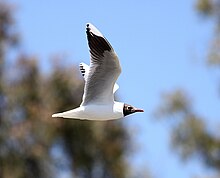Patagonian gull
| Patagonian gull | ||||||||||||
|---|---|---|---|---|---|---|---|---|---|---|---|---|

Patagonian gull ( Chroicocephalus maculipennis ) |
||||||||||||
| Systematics | ||||||||||||
|
||||||||||||
| Scientific name | ||||||||||||
| Chroicocephalus maculipennis | ||||||||||||
| ( Lichtenstein , 1823) |
The Patagonian gull ( Chroicocephalus maculipennis , syn .: Larus maculipennis ) is a species of gull native to South America and the Falkland Islands . Its appearance is reminiscent of the black-headed gull that is widespread in Eurasia and was at times classified as a subspecies of this gull species. However, it is more closely related to the black-headed black-headed gull and the red-billed gull .
The Patagonian gull is unmistakable in its range, as no other species has a comparable plumage. The IUCN classifies the Patagonian gull as harmless ( least concern ) because of its large distribution area .
Appearance
The Patagonian gull reaches a height of 35 to 37 centimeters. The wing length is 27.1 to 31 centimeters. Patagonian gulls weigh between 290 and 361 grams. The males tend to be slightly larger than the females.
Adult Patagonian gulls in their splendid dress have a gray-brown head and a gray-brown throat that contrast sharply with the pale gray-white neck, the white underside of the body and the tail. The mantle and the wing covers are light gray. The outer hand wings are white, the rest are white and black. The beak, legs and feet are dark red-brown, but in some individuals the shade of red is more pronounced. The eyes are dark brown with a narrow white eye ring. The brown head markings are missing in the plain dress , but the birds then have a brownish ear mark of different sizes .
Fledglings and not yet sexually mature Patagonian gulls have a light-colored head that has a brownish tinge. In the first winter, young birds have a scale-like, gray-brown mark on the wing cover or on the coat. The tail has a narrow black horizontal stripe.
Distribution and existence
The Patagonian Gull breeds on the coasts, swampy lakes and rivers from northeast Argentina, Uruguay and central Chile to Tierra del Fuego. It is also a breeding bird in the Falkland Islands. The population in the Falkland Islands appears to be largely resident birds. The breeding birds on the South American continent, on the other hand, migrate further north in winter and can then also be observed in northern Chile, northern Argentina and eastern Brazil.
The population is estimated by the IUCN at 100,000 to one million sexually mature individuals.
Way of life
Patagonian gulls are largely insect eaters. They often follow plowing tractors and catch insects from the air over marshland and grasslands. They also eat small fish, carrion, and garbage.
The breeding season falls in the period October to January. The species breeds in colonies that contain up to 500 breeding pairs. In the breeding colonies it is occasionally associated with the black-billed gull or the falconry tern ( Sterna hirundinacea ). Most breeding pairs build their nests out of grass, some like the terns also build their nests on floating swamp vegetation or use the nests of grebes . The clutch usually consists of two to three eggs.
supporting documents
literature
- Hadoram Shirihai: A Complete Guide to Antarctic Wildlife - The Birds and Marine Mammals of the Antarctic Continent and Southern Ocean , Alula Press, Degerby 2002, ISBN 951-98947-0-5
Single receipts
- ↑ Shirihai, p. 230
- ↑ a b BirdLife Factsheet on the Patagonian Gull , accessed on December 4, 2010
- ↑ Shirihai, p. 230
- ^ Shirihai, p. 229
- ↑ Shirihai, p. 230
Web link
- Larus maculipennis inthe IUCN 2013 Red List of Threatened Species . Listed by: BirdLife International, 2012. Retrieved January 14, 2014.
